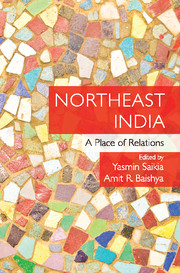Book contents
- Frontmatter
- Contents
- List of Figures
- List of Boxes
- List of Tables
- Acknowledgments
- Introduction
- Section I Contemporary Politics and Issues of Definition
- 1 Solidarity, Visibility and Vulnerability: ‘Northeast’ as a Racial Category in India
- 2 India and its Northeast: Another Big Push without a Take-Off?
- 3 (Un)natural Disasters and the Role of the State in the Brahmaputra Valley, Assam
- Section II Creating Presence
- Section III Knowing through Experience
- Section IV Rethinking Politics
- Glossary
- About the Contributors
- Index
3 - (Un)natural Disasters and the Role of the State in the Brahmaputra Valley, Assam
from Section I - Contemporary Politics and Issues of Definition
Published online by Cambridge University Press: 23 July 2017
- Frontmatter
- Contents
- List of Figures
- List of Boxes
- List of Tables
- Acknowledgments
- Introduction
- Section I Contemporary Politics and Issues of Definition
- 1 Solidarity, Visibility and Vulnerability: ‘Northeast’ as a Racial Category in India
- 2 India and its Northeast: Another Big Push without a Take-Off?
- 3 (Un)natural Disasters and the Role of the State in the Brahmaputra Valley, Assam
- Section II Creating Presence
- Section III Knowing through Experience
- Section IV Rethinking Politics
- Glossary
- About the Contributors
- Index
Summary
Introduction
It was a cold January morning in Majuli. After riding my motorcycle for a little over an hour on an earthen embankment that ran parallel to the Brahmaputra, I reached the gaonbura's (village headman) home at Salmora, a village devastated by years of flood and riverbank erosion. Since this was an unusual occurrence at this time of the year, the gaonbura informed me about ongoing erosion in the village. After a brief chat over a cup of tea, we both headed to the riverside to meet the erosion-affected families. We stopped by at Manik Hazarika's house. Hazarika, a visibly frail man in his mid-80s, was sitting on the verandah of his modest house, gazing at the mighty Brahmaputra, while his sons were working in the family farm, which was already on the verge of being eroded. For the past eleven years, the Hazarika family had been living in the current house – a stilt house, now typical of Salmora, with wooden floor, tin roof and walls made of bamboo with earthen plastering on both sides. In mid-February, when I visited the family again, the old house was gone, the farm had disappeared and the family was living in a makeshift tent nearby. A month later, when I again went to meet the family, they had moved farther away from the river and were in the process of rebuilding their home, which they completed over the next couple of months. There were only three or four houses in this area where the Hazarika family had newly moved in, but within a year's time, more than a dozen houses came up there as erosion continued to displace families in the riverside area. Once during a conversation, Hazarika expressed his anguish thus: ‘We have been like the aghoris (the nomads). We do not have a permanent home, always on the move from one place to another. […]. The government does not care about us. We are the forgotten citizens.’
Close to Salmora was Sumoimari, another large village devastated by flood and erosion. Cases like Manik Hazarika's were commonplace in Sumoimari as well, but the story of Robiram Kutum's family was worse.
- Type
- Chapter
- Information
- Northeast IndiaA Place of Relations, pp. 68 - 90Publisher: Cambridge University PressPrint publication year: 2017



